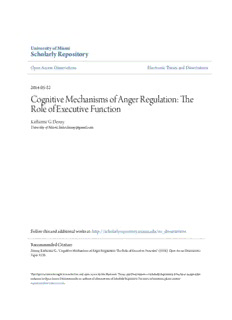
Cognitive Mechanisms of Anger Regulation: The Role of Executive Function PDF
Preview Cognitive Mechanisms of Anger Regulation: The Role of Executive Function
University of Miami Scholarly Repository Open Access Dissertations Electronic Theses and Dissertations 2014-05-22 Cognitive Mechanisms of Anger Regulation: The Role of Executive Function Katherine G. Denny University of Miami, [email protected] Follow this and additional works at:https://scholarlyrepository.miami.edu/oa_dissertations Recommended Citation Denny, Katherine G., "Cognitive Mechanisms of Anger Regulation: The Role of Executive Function" (2014).Open Access Dissertations. 1220. https://scholarlyrepository.miami.edu/oa_dissertations/1220 This Open access is brought to you for free and open access by the Electronic Theses and Dissertations at Scholarly Repository. It has been accepted for inclusion in Open Access Dissertations by an authorized administrator of Scholarly Repository. For more information, please contact [email protected]. UNIVERSITY OF MIAMI COGNITIVE MECHANISMS OF ANGER REGULATION: THE ROLE OF EXECUTIVE FUNCTION BY Katherine G. Denny A DISSERTATION Submitted to the Faculty of the University of Miami in partial fulfillment of the requirements for the degree of Doctor of Philosophy Coral Gables, Florida August 2014 ©2014 Katherine G. Denny All Rights Reserved UNIVERSITY OF MIAMI A dissertation submitted in partial fulfillment of the requirements for the degree of Doctor of Philosophy COGNITIVE MECHANISMS OF ANGER REGULATION: THE ROLE OF EXECUTIVE FUNCTION Katherine G. Denny Approved: ________________ _________________ Matthias Siemer, Ph.D. Bonnie E. Levin, Ph.D. Assistant Professor of Psychology Professor of Neurology and Psychology ________________ _________________ Jutta Joormann, Ph.D. Heather Henderson, Ph.D. Associate Professor of Psychology Associate Professor of Psychology ________________ _________________ Frank Penedo, Ph.D. M. Brian Blake, Ph.D. Professor of Medical Social Sciences Dean of the Graduate School DENNY, KATHERINE G. (Ph.D, Psychology) Cognitive Mechanisms of Anger Regulation: (August 2014) The Role of Executive Function Abstract of a dissertation at the University of Miami. Dissertation supervised by Professor Matthias Siemer. No. of pages in text. (135) Anger is a prevalent and powerful emotion, arising when another person has thwarted a self-relevant goal or event, and increased effort is required for goal achievement. While the majority of research indicates that anger is an affective precursor to aggression, recent research implies that anger may also have beneficial consequences – at least for some people in some situations. With the negative cost of anger often being severe, and yet the potential that anger utilization can lead to enhanced performance, it is important to understand individual differences in the ability to regulate and utilize anger. To explore this area of research, this study applied the current understanding of the connection between executive functions (EF) and emotion regulation (ER) to an examination of anger and anger regulation. Cognitive ER (e.g., reappraisal) is an effective way to regulate emotions such as anger, and has been examined at the level of daily functioning. It has been demonstrated that general cognitive control is related to ER, however only minimal research has examined the role of specific aspects of EF on ER, and this has not been examined specifically in the context of anger regulation. In light of this lack of information regarding the role of EFs in anger regulation, undergraduate participants (n=101) completed behavioral and physiological measures to examine the influence of distinct components of EF (Inhibition and Shifting) on the ability to regulate induced anger and perform on a frustrating visual motor task. My results begin to establish a connection between EF and anger regulation. This relationship is complex but it is identified through three main findings, 1) biased attention (vigilance) to anger can affect ER; improving it under some circumstances, diminishing it in others, 2) a subset of Shifting and Inhibition results support the existence of a role of cognitive ER strategies in anger regulation, 3) EF with happy stimuli is associated with lower self-report anger, but worse performance on a frustrating task. Overall, these findings indicate a potentially important role of EF in emotion regulation, but highlight the complexity of this relationship. They provide a refined focus for future studies. Furthermore, this study has important implications for identifying neural components that promote successful utilization, as well as for understanding neurological deficits associated with an inability to regulate anger, a common sequela of traumatic brain injury (TBI). With this information I hope to increase our ability to identify, prevent, and treat the detrimental emotional disturbances caused by TBI in military personnel and athletes. TABLE OF CONTENTS Page List of Figures .............................................................................................................. iv List of Tables .............................................................................................................. v Chapter 1 INTRODUCTION ......................................................................................... 1 2 METHODS .................................................................................................... 27 3 RESULTS ....................................................................................................... 39 4 DISCUSSION .................................................................................................. 53 References .............................................................................................................. 70 Figures .............................................................................................................. 78 Tables .............................................................................................................. 82 Appendix A .............................................................................................................. 122 Appendix B .............................................................................................................. 123 Appendix C .............................................................................................................. 126 Appendix D .............................................................................................................. 127 Appendix E .............................................................................................................. 133 ii i LIST OF FIGURES Page FIGURE 3.1 .............................................................................................................. 78 FIGURE 3.1 .............................................................................................................. 79 FIGURE 3.1 .............................................................................................................. 80 FIGURE 3.1 .............................................................................................................. 81 iv LIST OF TABLES Page TABLE 3.1 .............................................................................................................. 82 TABLE 3.2 .............................................................................................................. 83 TABLE 3.3 .............................................................................................................. 84 TABLE 3.4 .............................................................................................................. 85 TABLE 3.5 .............................................................................................................. 86 TABLE 3.6 .............................................................................................................. 87 TABLE 3.7 .............................................................................................................. 88 TABLE 3.8 .............................................................................................................. 89 TABLE 3.9 .............................................................................................................. 90 TABLE 3.10 .............................................................................................................. 91 TABLE 3.11 .............................................................................................................. 92 TABLE 3.12 .............................................................................................................. 93 TABLE 3.13 .............................................................................................................. 94 TABLE 3.14 .............................................................................................................. 95 TABLE 3.15 .............................................................................................................. 96 TABLE 3.16 .............................................................................................................. 97 TABLE 3.17 .............................................................................................................. 98 TABLE 3.18 .............................................................................................................. 99 TABLE 3.19 .............................................................................................................. 100 TABLE 3.20 .............................................................................................................. 101 TABLE 3.21 .............................................................................................................. 102 v TABLE 3.22 .............................................................................................................. 103 TABLE 3.23 .............................................................................................................. 104 TABLE 3.24 .............................................................................................................. 105 TABLE 3.25 .............................................................................................................. 106 TABLE 3.26 .............................................................................................................. 107 TABLE 3.27 .............................................................................................................. 108 TABLE 3.28 .............................................................................................................. 109 TABLE 3.29 .............................................................................................................. 110 TABLE 3.30 .............................................................................................................. 111 TABLE 3.31 .............................................................................................................. 112 TABLE 4.1 .............................................................................................................. 113 TABLE D.1 .............................................................................................................. 114 TABLE D.2 .............................................................................................................. 115 TABLE D.3 .............................................................................................................. 116 TABLE D.4 .............................................................................................................. 117 TABLE D.5 .............................................................................................................. 118 TABLE D.6 .............................................................................................................. 119 TABLE D.7 .............................................................................................................. 120 TABLE D.8 .............................................................................................................. 121 vi
Description: